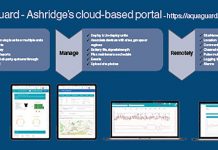Event Duration Measurement (EDM) in Combined Sewer Overflow (CSO) applications has, rightly, become a significant focus for our water operators.
Management of pollution under flood conditions is a significant challenge and, with ever more demanding monitoring regimes, thousands of CSO monitoring installations have been implemented and thousands more planned, involving data logging and level measurement to record spill events. Looking beyond CSO, there are good reasons to monitor flow throughout the waste water network to identify problem areas and inform maintenance regimes. The latest generation of more cost effective and reliable instruments are making ever more sophisticated catchment planning and water infrastructure response possible by lowering the cost of adding more data points to the network.
With many CSO in relatively remote places, new instrumentation has been developed specifically for the application that combines accuracy and reliability with ultra-low power consumption. Devices such as Pulsar’s dBi non-contacting ultrasonic level transducers have found a real niche in this application, with 75% of all dBi sales world-wide now going into CSO measurement for CSO and EDM schemes. Further development has led to a ‘companion’ instrument, Pulsar’s MicroFlow-i, a low power non-contacting microwave unit that sits above a channel and uses a novel spread spectrum analysis approach to measure the flow velocity. Velocity can be integrated with the level measurement to derive a flow rate using a relatively simple velocity x area calculation, although the two measurements don’t necessarily need to be used in this way. Changing velocity of flow, even without a spill event, will indicate changing network conditions and allow action to be taken or the data to be gathered. In many cases it is sufficient to know, reliably, that liquid is flowing within normal upper and lower boundaries. We can therefore measure the velocity of the flow to monitor a normal condition – for example within a channel where an excessive, or restricted flow velocity may indicate a process issue further upstream.
It’s always worth repeating that the functions and features of any instrument don’t matter in the slightest if the core measurement isn’t reliable. There is no point in having a seamless telemetry signal and direct integration into a wider set of network analytics if you can’t rely on the core measurement being stable and reliable. Pulsar’s dBi is a self-contained non-contacting ultrasonic level measurement transducer with up to 15m measurement range that features the same DATEM echo processing algorithm that has been proven and refined across tens of thousands of applications world-wide, the vast majority of which have been in demanding water/waste water projects. Pulsar have the most accurate MCERTS approved open channel flow measurement system in their FlowCERT controller. To continue to use the Pulsar dBi as an example, power usage is minimised in a battery-powered remote site by ‘waking up’ the transducer periodically – typically every 2 minutes. The dBi has been designed to have a very short wake-up cycle so makes a measurement, delivers the reading, and then goes back to sleep. It can be set up to wake more often and take more readings if an event, as determined by limits set in programming, is occurring – i.e. if the level is high or rising quickly.
For velocity measurement, Pulsar’s MicroFlow represents a new generation of low cost microwave devices that are compact and deliver repeatable, reliable velocity measurement. Traditionally, flow velocity has been measured using contacting devices, typically turbines or Doppler immersion probes. These have been highly successful but occasionally problematic, obviously potentially prone to fouling and, particularly the Doppler sensor, reliant on various conditions within the flow. Pulsar’s MicroFlow uses a compact transducer, which is positioned above the flow and makes a non-contacting measurement of flow velocity. A simple bracket can be used to mount the transducer at the optimum angle, so they are easy to install, maintenance free and installation usually causes no interruption to the process.
Measuring velocity using a non-contacting technique is a very complex challenge analytically, and has only really become realistic with the faster processors now available to instrumentation designers. Pulsar use a technique called RSSA (Refracted Spread Spectrum Analysis). In MicroFlow, a pulse is fired at the liquid surface, producing a mass of reflections from the full width of the channel, up to 1.5m width. Multiple sensors can form an array to measure across wider channels. If this were a level measurement application, we would be looking for a single strong signal. In this application, the MicroFlow applies the RSSA algorithms to analyse and integrate the received signals, then slices them for real-time analysis and velocity calculation. MicroFlow can be used as a stand-alone device that delivers velocity data via RS485 Modbus. In order to address the challenges of EDM type applications in remote locations, Pulsar have developed an ultra-low power version, MicroFlow-i. Communicating through HART or a 4-20mA signal, MicroFlow-i allows the same wake-up profile as the dBi, perfect for CSO measurement.
When considering Catchment Management, then the CSO is only part of the story, of course. The more data points that can be captured, the better. The situations will vary, some will be in open channels but probably more will still be in closed pipes. Pulsar have created another class of flow monitoring equipment that also uses Spread Spectrum Analysis, operating as a clamp-on, non-invasive device that gives reliable, repeatable flow rate indication.
With relatively low cost per installation, this type of measurement can be more generally deployed within a process, so managers can have real clarity of flow profiles within their operations. This is important when considering sophisticated management techniques such as Catchment Planning and Water Infrastructure Response. Data needs to be gathered throughout the system and in a variety of situations. CSO most crucially, perhaps, but also throughout the sewer network, where changing flow rates can warn of spills and allow planning for future investment to minimise and mitigate the effect of stormwater pollution. A complete system of measurement devices, tied into relatively simple network telemetry and datalogging tools can now provide real-time visualisation of the network. The catchment approach naturally leads on to an infrastructure response model, but in order to reach that point the system has to be accurately modelled, and in order to get there, we have to know what is happening throughout the network, not just at the pinch points. New processing and new instruments from the leading suppliers is now making that vision a reality.
www.pulsar-pm.com







